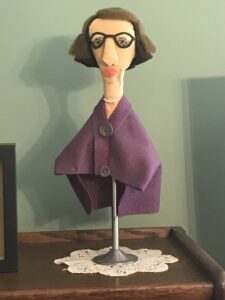

MARY FLANNERY O’CONNOR (1925-1964)
Celebrated Southern Gothic writer of short stories, letters, essays and novels
“The truth doesn’t change based on our ability to stomach it.” FO
Recently I visited Savannah, Georgia for an anniversary retreat and while I was there I checked on the first statue I ever wrote about: Waving Girl. Turns out, Florence Martus is thriving and now has her own memorabilia which will come in handy when my novel, Waving Girl’s Last Stand, drops. Just kidding- I’m still waiting for the elusive agent to reveal themself.
But while I was on a ghost tour enjoying the most haunted city in America, I stumbled upon Flannery O’Connor’s childhood home. Since someone once compared her stinging language with my own dark and wry writing style –it was only the one time but the comment gave my writing buoyancy – I jumped at a chance to learn more about her. When I went home and goggled her, thinking someone had already memorialized her with a monument, I found nothing. I was shocked because during the tour of her home I learned that a group of English professors had garnered funding to restore her home and turn it into a museum. Certainly there was more. All I found, bedsides a dollish puppet-like replica of her found in the home, was a bust of her sculpted by Italian artist, Valentine Mazzei, in Sept. 2011. She was part of a series of portrait busts (such as Emily Dickinson, Virginia Woolf, Gertrude Stein and Carson Mc Culler) about women who had made significant contributions to the field of writing and had impacted the artist deeply with their emotional truths. The bust is now part of the Chicago Loyola’s University Center for Catholic Intellectual Collection.
There’s so much to say about Flannery (she dropped her given name Mary after publishing her first work, The Geranium in 1946). She was a woman with a prolific writing career during her short life-span of 39 years. Even after her diagnosis of lupus (a disease where the immune system attacks the organs in the body), which is the same illness that contributed to her father’s untimely death, she went on to publish 2 novels, 31 short stories, and numerous essays and letters. In 1972 (eight years after her death) she was awarded the National Book Award for Fiction for her collected works, The Complete Stories, still considered to be one of the best short-story collections. If you haven’t read her genius-level writing, often referred to as having an offbeat humor while depicting the unsavory acts of humanity, I suggest you start with her tour-de-force short story, A Good Man is Hard to Find, which is arguably the best title of any work ever published. The story highlights her brilliant use of grotesque characters in violent situations often engaging in battles of good vs. evil where the villain isn’t always easy to find. Definitely my kind of writer.
Now for the dark side, and with an author who thinks revulsion and soul-eating revelations are for catechism classes, there’s going to be a group of naysayers who want to make sure any thoughts of a bronze statue ever leave the artist’s sketch pad. As a southern girl, born Irish Catholic and reared in an environment where bigotry ran rampant (and not just toward people of color as evidenced by this SC sign “Help wanted: No Irish Need Apply) some non-fans have claimed that her writing is inherently embedded with racism. I’m going to lean into Angela O’Donnell’s 2020 non-fiction book, Radical Ambivalence; Race in Flannery O’Connor, where she believes Flannery was limited by her time and place and the culture of bigotry that birthed her. Flanner followed a southern code of manners yet many of her white characters are despicable human beings who meet violent ends. Some scholars will give her writing a color pass (she was a rare brave writer who told the truth, warts and all, damn the consequences) while others point to her personal letters where she spoke her mind. But mining her private life until you find a morsel of evidence is like finding her clothesline full of laundry where everything has blown away except her lacy black bra and then using her undergarments to imply she was immoral. I guess fact-checking hadn’t been invented yet.
As for the woman who’s been deemed “the mother of the modern short story,” Flannery’s writing is rooted in outlandish content and then flavored in satire and then marinated in mystery until it evokes a visceral response. A potent recipe that doesn’t go down well with everyone.
However, we need women like her to be remembered and memorialized. She’s the kind of women we should still be talking about centuries from now. Yes, we have her writings, now translated into to 20 languages, her portrait bust and a small museum in SC. These are all good starts. But we need more of her. Bigger, brighter, shinier, louder; just like her.
Readers, we can make this happen. Let’s not rest until the landscape of our world is dotted with monuments of the matriarchy. Bronze. Marble. Granite. Stone. Silver. Glass.
Women lag way beyond men in the statue race. Let’s even the score.
Get chiseling!